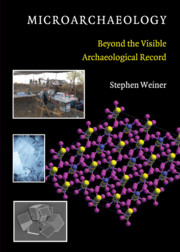Book contents
- Frontmatter
- Contents
- Preface
- 1 Archaeology, Archaeological Science, and Microarchaeology
- 2 Information Embedded in the Microscopic Record
- 3 Completeness of the Archaeological Record
- 4 Common Mineral Components of the Archaeological Record
- 5 Biological Materials: Bones and Teeth
- 6 Biological Materials: Phytoliths, Diatoms, Eggshells, Otoliths, and Mollusk Shells
- 7 Reconstructing Pyrotechnological Processes
- 8 Biological Molecules and Macromolecules: Protected Niches
- 9 Ethnoarchaeology of the Microscopic Record: Learning from the Present
- 10 Absolute Dating: Assessing the Quality of a Date
- 11 Reading the Microscopic Record On-Site
- 12 Infrared Spectroscopy in Archaeology
- Appendix A Identifying Minerals Using Microchemical Analysis
- Appendix B Identifying Minerals and Compounds Using Infrared Spectra: Table of Standard Minerals and Compounds for Which Infrared Spectra Are Available
- References
- Index
- Plates section
9 - Ethnoarchaeology of the Microscopic Record: Learning from the Present
Published online by Cambridge University Press: 05 June 2012
- Frontmatter
- Contents
- Preface
- 1 Archaeology, Archaeological Science, and Microarchaeology
- 2 Information Embedded in the Microscopic Record
- 3 Completeness of the Archaeological Record
- 4 Common Mineral Components of the Archaeological Record
- 5 Biological Materials: Bones and Teeth
- 6 Biological Materials: Phytoliths, Diatoms, Eggshells, Otoliths, and Mollusk Shells
- 7 Reconstructing Pyrotechnological Processes
- 8 Biological Molecules and Macromolecules: Protected Niches
- 9 Ethnoarchaeology of the Microscopic Record: Learning from the Present
- 10 Absolute Dating: Assessing the Quality of a Date
- 11 Reading the Microscopic Record On-Site
- 12 Infrared Spectroscopy in Archaeology
- Appendix A Identifying Minerals Using Microchemical Analysis
- Appendix B Identifying Minerals and Compounds Using Infrared Spectra: Table of Standard Minerals and Compounds for Which Infrared Spectra Are Available
- References
- Index
- Plates section
Summary
The idea of using ethnographic data to better understand past societies is very old. Van der Kooij (2002) pointed out that even in 1727, Christiaan Schoettgenius made ethnographic observations to better understand agricultural methods in antiquity. The study of extant traditional societies as a key to the past started in earnest more than a century ago (Orme, 1974). In 1899, an ethnographer, Harlan Smith, appealed to archaeologists to have more awareness of ethnography as it would improve their understanding of archaeological material (Smith, 1899). This aspect of ethnography is referred to as ethnoarchaeology. Braidwood was among the initiators of the modern era of systematic ethnoarchaeological research, together with his two students Watson (1979) and Kramer (1982). These studies, as well as those of Binford (1983), Brain (1967a, 1967b, 1981), Gould (1980), and Yellin (1977), in many respects laid the foundations of this field.
Ethnoarchaeology can provide a reference framework for interpreting the archaeological record, and by applying archaeological methods to ethnographic contexts, it can provide a means of validating these methods (Isaac, 1968). The ethnographic context is also an excellent environment for developing new analytical tools for studying the archaeological record (Binford, 1978). Many have noted the potential pitfalls of using ethnographic observations as direct analogies to the archaeological record, but here, too, with caution, the insights gained can be helpful (Orme, 1974). To date, very little attention has been paid to the microscopic ethnoarchaeological record – the topic of this chapter.
- Type
- Chapter
- Information
- MicroarchaeologyBeyond the Visible Archaeological Record, pp. 227 - 244Publisher: Cambridge University PressPrint publication year: 2010



